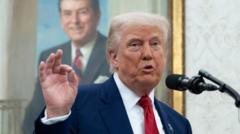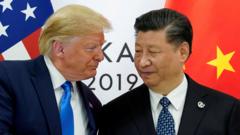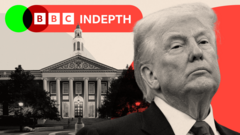The Court of International Trade has invalidated Trump's broad tariff provisions, posing significant questions about executive power in economic regulation.
US Trade Court's Ruling Challenges Trump's Tariff Power: Next Steps Explained

US Trade Court's Ruling Challenges Trump's Tariff Power: Next Steps Explained
A landmark court decision has impacted Trump's tariff policies, raising questions about the future of American trade.
A federal court has made a substantial ruling against President Donald Trump’s expansive tariffs, marking a critical moment for US trade policy and executive authority. The Court of International Trade declared that the emergency powers invoked by the Trump administration to impose tariffs on numerous countries were unconstitutional and exceeded the president’s lawful powers. The court maintained that the US Constitution gives Congress sole authority to regulate foreign commerce, thus nullifying the tariffs implemented under the International Emergency Economic Powers Act (IEEPA) of 1977.
The legal challenge was initiated by the Liberty Justice Center, representing five small businesses affected by the tariffs, which were colloquially referred to as "Liberation Day" tariffs. By rejecting the administration's justifications, the court also invalidated separate tariffs targeting China, Mexico, and Canada based on concerns over drugs and illegal immigration.
The White House quickly responded to the ruling, with Deputy Press Secretary Kush Desai asserting that "it is not for unelected judges to decide how to properly address a national emergency." Conversely, New York Attorney General Letitia James, representing a coalition of states, applauded the decision, emphasizing the detrimental impact of the tariffs on American families and businesses. She claimed these taxes could lead to increased inflation and economic downturns.
Market reactions following the court's decision were largely optimistic, with stock markets in Asia and US futures experiencing gains. Analysts suggest this ruling has provided a momentary sense of stability in a tumultuous trade environment marked by fluctuations related to ongoing tariffs and trade negotiations.
The next steps for the White House involve a 10-day period for administrative adjustments to halt the tariffs, although many are currently suspended. The administration has indicated plans to appeal the court's ruling. If those appeals fail, the US Customs and Border Protection Agency will be directed to implement changes, potentially refunding tariffs paid with interest to affected businesses.
The court’s decision signals a potential check on executive power concerning tariffs, sending a message that there are constitutional limits to unilateral economic actions taken by the president. The narrative surrounding Trump's trade policies could shift from unilateral authority to adherence to established legal frameworks.
Historically, tariffs under Trump's administration leading up to this moment have caused significant upheaval, including widespread market volatility and escalating tensions between the US and its trade partners. After announcing broad tariffs in April and fluctuating policies amid trade negotiations, the court's decision presents a pivotal turning point in how trade laws may evolve in light of executive action and legislative oversight.





















